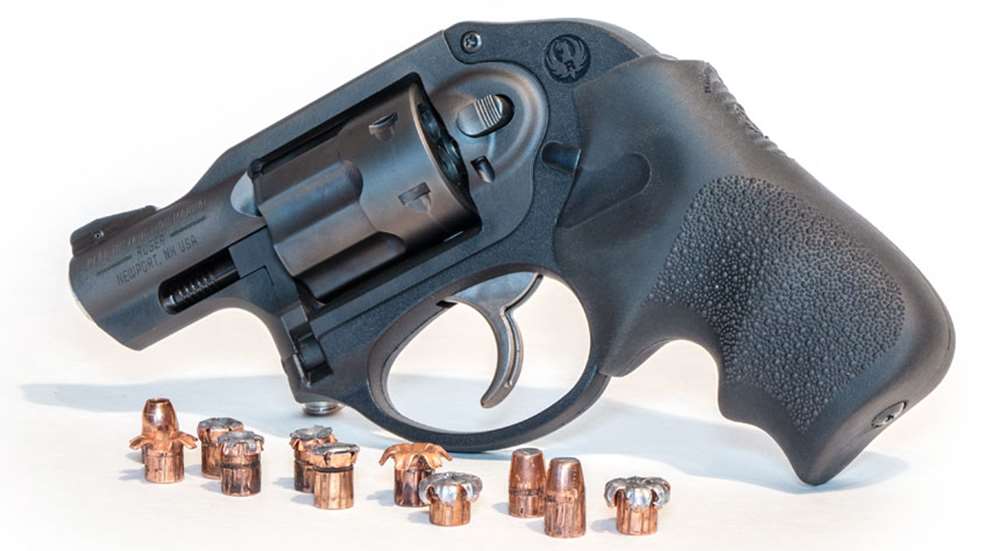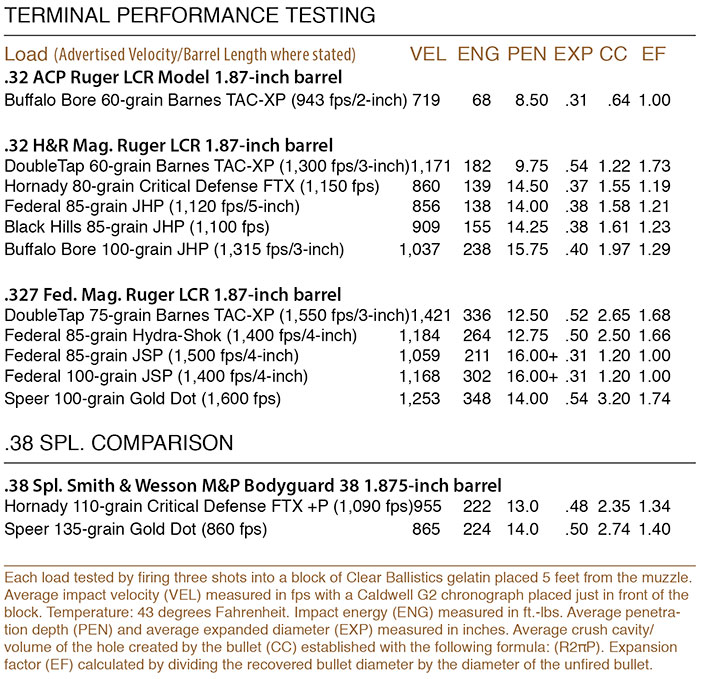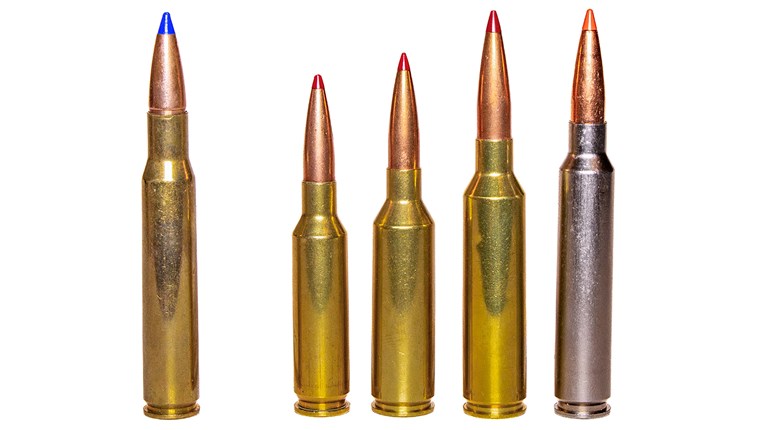
Multiple defensive loads exist for concealed-carry revolvers like this Ruger LCR. No matter what handgun you carry, knowing how your ammo selection performs out of it is important.
I recently picked up a 17-ounce Ruger LCR in .327 Fed. Mag. When knocking around in the field or hunting, I carry a Ruger Single Seven—the Lipsey’s Distributor Exclusive model with XS Sights that I helped design. Point is, I shoot a lot of .32 H&R Mag. and .327 Fed. Mag. ammunition, so keeping a compact, carry revolver handy that will shoot the same ammunition made sense. I felt it would also make a fantastic house gun, especially since .32 H&R Mag. recoil is something everyone in the house can handle.
Out of my 4.62-inch-barreled Single-Seven, I’ve conducted terminal-performance testing with every commercial .32 H&R Mag. and .327 Fed. Mag. load available. But, barrel length matters. I knew the prudent thing was to conduct similar testing with the LCR. Yeah, there’s lots of test results on the internet, but I like doing my own, partly because I often find discrepancies between my testing and others’. Mainly because I’ve been testing bullets in various test mediums for a long time, I trust me. I had several blocks of Clear Ballistics on hand, and while I don’t consider it the best test medium, it’s much easier to work with than ordnance gelatin. So, I assembled 11 loads I felt suitable for my purposes and tested them out of the little Ruger.
You may not realize it, but you can fire .32 ACP ammunition in a .327 Fed. Mag. revolver. Buffalo Bore offers a .32 ACP load that uses a 60-grain Barnes TAC-XP bullet. Advertised velocity out of a 2-inch-barreled Seecamp semi-automatic is listed at 943 fps. I thought this might be a light-recoiling option, but out of the LCR the load only clocked 719 fps. There was not enough velocity to initiate bullet expansion.
I tested five .32 H&R Mag. loads and penetration ranged from 9.75 to 15.75 inches. The DoubleTap load was the only load that did not meet the FBI’s 12-inch minimum depth requirement. It also bucked hard, with felt-recoil similar to .327 Fed. Mag. loads. With all the .32 H&R Mag. loads, actual velocities out of the short-barreled LCR ranged from 191 to 290 fps slower than advertised, with an average velocity loss of 230 fps. Based on the limited expansion, it seems apparent the two 85-grain loads and the single 100-grain load could have benefited from a bit more speed.
Similarly, the muzzle velocities of the .327 Fed. Mag. loads averaged 273 fps less than advertised. This disparity illustrates the importance of such testing; a certain velocity is needed to initiate bullet expansion/deformation. For example, out of my 4.62-inch-barreled Single-Seven, the Federal 100-grain JSP load will exit the barrel at—as advertised—1,400 fps. It will also expand to about 1.6 times its original diameter. This load only generated 1,168 fps from the snubby Ruger and didn’t expand at all. Similarly, the only time I’ve ever seen the Federal 85-grain JSP load expand is when fired from a rifle.
The 75-grain DoubleTap load came the closest to living up to its advertised velocity at only 129 fps short. However, this load generated a muzzle flash leaving you with a momentary concern the revolver had just exploded in your hand. The Federal Premium 85-grain Hydra-Shok load generated an almost identical level of felt recoil, but the Speer 100-grain Gold Dot load had noticeably more bite. That said, it was clearly the most potent option out of this little revolver. On the other hand, I’m not sure it’s worth the extra recoil. Shooting at a 5-inch circle at 5 yards, I found I could put six rounds of the Hydra-Shok load on target a full 1.5 seconds faster than with the Speer load.
How do these loads compare to .38 Spl. loads out of a short-barrel revolver? One of the best .38 Spl. loads I’ve tested is the Speer 135-grain +P Gold Dot Short Barrel load. It’ll penetrate to about 14 inches and expand to about a half-inch. The resulting crush cavity—based on penetration depth and expanded bullet diameter—consistently measures at a volume of about 2.75 cubic inches. This is, for all practical purposes, identical to the performance of the best three .327 Fed. Mag. loads fired from the LCR.
This brings me to the main point I’d like to make, and that’s how I think you ought to be comparing terminal performance. With defensive-handgun ammunition, bullet weight alone means nothing; its contribution is ultimately measured in penetration. In most cases, the same goes for velocity, as long as the bullet expands. Kinetic energy doesn’t matter much either. The .327 Fed. Mag. 100-grain JSP load generates more energy than both .38 Spl. loads shown for comparison. However, the crush cavities created by both .38 Spl. loads were twice as large.
The crush cavity created by common defensive-handgun bullets may in fact be the best way to compare wounding potential. It’s relatively easy to calculate, just plug the values into this formula: (R2πP), where, R is the radius of expanded bullet, π is, of course, 3.14, and P is penetration depth. For example, with a bullet expanding to .50 inch and penetrating to 14 inches, the formula would look like: (.252π14) = 2.74. The key is to base any comparisons on test data obtained out of the gun you will be carrying as opposed to advertisements and data obtained with other handguns, especially those with longer barrels.
Regardless of the handgun/cartridge you’re considering, testing like this can help you make an informed decision about which load to use.







































